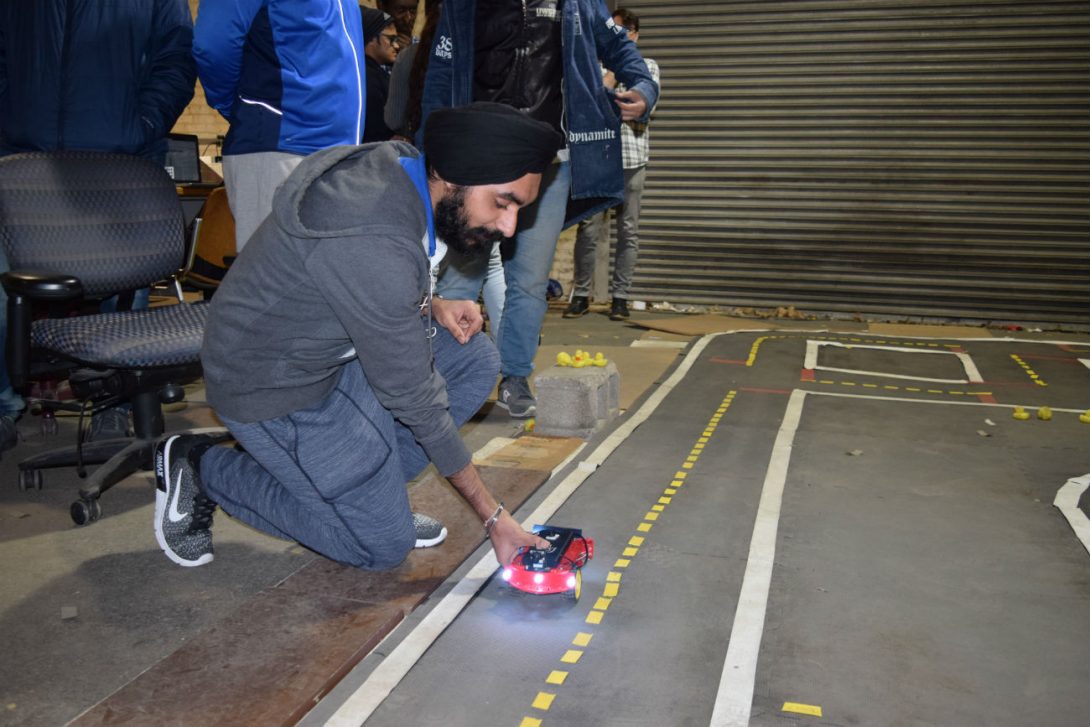Engineering students take on autonomous vehicles in new multidisciplinary course
Engineering students take on autonomous vehicles in new multidisciplinary course

This spring, a group of 60 UIC College of Engineering students feel like they won the lottery. In a way, they did—they were the lucky group selected via a lottery from among many students clamoring to participate in a full course on autonomous vehicles (AVs). This first-of-its-kind, interdisciplinary class is providing graduate students with a look at all the major issues relating to the development and eventual widespread implementation of AVs.
“Who wouldn’t want to take this course?” said Akshay Sachdeva, an electrical and computer engineering major. “This is the first time they’ve organized this subject, and it’s a fantasy for us.”
The course includes 15 guest lecturers, and is coordinated by four core faculty members; Ugo Buy (computer science), Jane Lin (civil and materials engineering), Michael Scott (mechanical and industrial engineering) and Milos Zefran (electrical and computer engineering).
The AV course is the first in a number of interdisciplinary projects being developed by college of engineering faculty, in collaboration across departments. The projects will focus on various topics with societal and global importance.
“The Autonomous Vehicles group is the first in the College of Engineering Research Working groups aimed at promoting cross-disciplinary collaboration. The innovative efforts of the AV group faculty serve as a fine illustration of the virtues of faculty working together on grand challenge problem areas,” said Venkat Venkatakrishnan, associate dean of research and graduate studies for the college.
In designing the AV course, the core faculty members discussed the issues that surround autonomous vehicles—from ethical concerns to traffic congestion, to economic and environmental impacts.
“The one thing we decided that was important about training AV engineers of the future is that they should be really conversant with some of the implications that are outside of the strictly technical,” said Scott, who has worked extensively with UIC’s Interdisciplinary Product Development program.
As a result, lecture topics run the gamut, from power consumption, computer vision, and signal processing—what one might expect in an engineering course centered around AV design, to ethics in human-machine systems, public policy, and philosophy.
Each student has a different reason for wanting to take part in the class. Peter Lauer, a civil and materials engineering major, works at a not-for-profit shared-use mobility center, and has been studying consequences associated with various transportation choices. He is curious about the effects of AVs on pedestrians, and on other transportation choices.
“Are cities declining to invest in other transit sources due to the potential for AVs? I wanted to understand more on the technical side,” Lauer said.
“How do you predict the future demand of transportation, in this case specifically for AVs? Who is going to use them, and what kind of ownership model are we going to have?” said Lin, whose main research focus is transportation planning and modeling.
Lin also works with the students to understand the impacts and challenges of mixing AVs with human-driven vehicles.
One of the bigger surprises in the class for the students so far has been the ethics and philosophy lessons.
“We have to realize that as good as we write code, or as well as a program works it’s very important to consider that this impacts people,” said Oluwadamilola Saka, a mechanical and industrial engineering student. “I am part of the narrative, and I should not just look at engineering design.”
For the technical portion of the class, groups of students use DuckieBots, part of the Duckietown platform, for programming their AVs. The small-scale autonomous robot platform was developed at MIT in 2016. A 10 foot by 20 foot roadway, or town, was set up in the UIC Makerspace, and students program their AVs to follow lanes on the floor, follow each other with interference from other vehicles, and learn to ‘platoon,’ or bunch together at relatively high speeds by wirelessly communicating with one another, which is a method to reduce roadway congestion.
“We calibrate the camera and teach it different sizes and shapes. It learns how to detect the distance between the camera and the car in front of it, then sends that to the controller, which is the heart of the autonomous car, which can tell it to stop,” said Sameer Ingale, a student in mechanical and industrial engineering.
The hardest assignment, several classmates agreed, was a fictitious scenario where an AV had to kill either one person, or five.
“The car had to choose this path, or that path. We had to write the justification letter, and it was difficult to come up with how we made that choice,” said Durga Kumari Pisipati, an electrical and computer engineering student, as her voice trailed off. “There are not enough apologies for this.”
Still, the students remain incredibly optimistic about the future of AVs, and almost all expressed interest in taking future courses, should they be offered. The faculty hope to grow the course, and build an AV program.
“We want the course to turn into a master’s level concentration or certificate program. There is quite a lot of interest from industry in this specialty,” said Zefran, who specializes in robotics, human-robot interaction, and control and safety of autonomous vehicle systems. “We are well-positioned in that Chicago is a transportation hub. That’s why we started the course.”
“We think it’s good to establish a research program in this area because autonomous vehicles will happen,” said Buy. “The convenience of not having to drive is just too great, and the public will demand them. It may be decades away but we will have it. This course is just the first step.”
Students interested in learning more about AVs should contact current faculty members, or visit the UIC AV research area online.